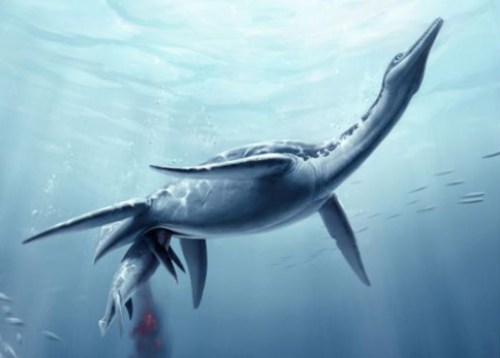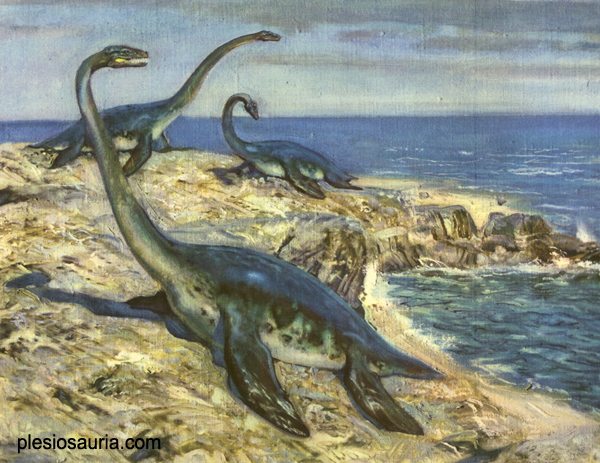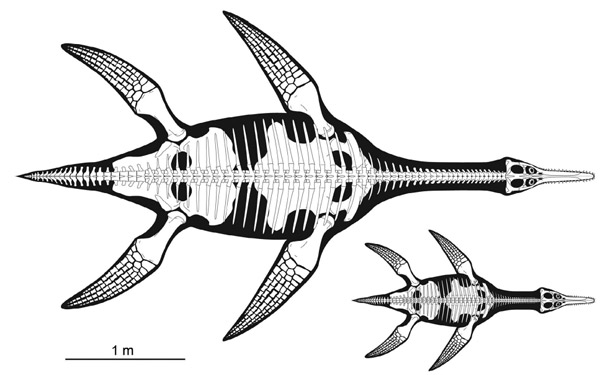An old debate settled – plesiosaurs gave birth to live young
An exciting new paper published this week in the journal Science (Vol. 333, p.870-873) provides the first direct evidence for live birth in plesiosaurs, and may have implications for plesiosaur behaviour (O’Keefe and Chiappe 2011).

Whether plesiosaurs laid eggs or gave birth to live young has been a topic of speculation for nearly 200 years. They have sometimes been portrayed crawling out of the water to lay eggs in the manner of sea turtles, and while palaeontologists have long suspected that plesiosaur anatomy is incompatible with movement on land, empirical evidence either way has been lacking.
The new evidence comes in the form of a fossil plesiosaur skeleton with a fetus preserved in the body cavity. Both individuals have diagnostic characteristics indicating they are the same species, the small individual displays embryonic features and is in the correct position to be a fetus, and there are no signs of it being eaten (bite marks or acid wear). These numerous lines of evidence confirm that this fossil represents a mother and her unborn fetus. This demonstrates that plesiosaurs did not lay eggs and were therefore able to lose their ties with land and spend their entire lives in the ocean.

The newly described fossil plesiosaur is a polycotylid (Polycotylus), one of the last types of plesiosaurs to evolve. It was discovered in Late Cretaceous rocks in Kansas, USA. Polycotylids were highly derived plesiosaurs with torpedo-shaped body outlines and wing-like flippers, a relatively short neck (as far as plesiosaurs go) and a very short tail. They were almost penguin-like in general appearance and also similar to penguins, they would have been fast and agile swimmers.
An unusual aspect of this fossil is the size of the fetus. Most viviparous reptiles give birth to a brood of several small individuals. In contrast, this new fossil shows that at least some plesiosaurs gave birth to a single very large individual, much like whales do today. Many other marine reptiles including ichthyosaurs and mosasaurs gave birth to live young, but this study suggests that plesiosaurs differed in that they invested energy and time into a single individual. This sort of reproductive strategy is often associated with gregarious behaviour and parental care, so the authors of the paper suggest that maybe plesiosaurs were excellent parents too. This hypothesis is fascinating although it would be quite unusual for reptiles.

Fossils of basal sauropterygians (pachypleurosaurs and nothosaurs), close relatives of plesiosaurs, also show that they gave birth to broods of several small live babies, so it is unclear when the evolutionary shift in reproductive strategy occurred in the sauropterygian lineage. It is certainly possible that the first plesiosaurs were more like their ancestors in terms of reproductive behavior. More fossils will ultimately be required to fill in the bigger picture, but for now, it is wonderful to be able to say with certainly that plesiosaurs gave birth to live young.
Reference
O’Keefe, F. R. and Chiappe, L. M. 2011. Viviparity and K-selected life history in a Mesozoic marine reptile. Science, 333, 870–873.

I know this is an obvious point, but it is worth making:
This specimen does not show that plesiosaurs gave life birth. It shows that Polycotylus did. You don’t need me to tell you that Plesiosauria was a huge, diverse, disparate and long-lived clade: what was true for one species may well not have been for another.
Polycotylus is one of the most derived plesiosaurs, and we know that basal sauropterygians gave birth to live young too. So a phylogenetic bracket for live birth in Sauropterygia would therefore include all plesiosaurs. Of course, this doesn’t apply to the more speculative behavioural aspects of this story – maybe early plesiosaurs gave birth to several small individuals.
Given the highly adapted anatomy of plesiosaurs, especially in their limbs, it is a pretty safe bet that they were not coming ashore to lay eggs like marine turtles. Beyond that, I don’t think we can conclude that they gave birth to only a single baby… this specimen may have been scavenged by sharks (note the scattered ribs and gastralia) or may have died in the process of given birth to other young. I’m not convinced that the fetus was only 2/3 grown… They could also have approximated the size of the birth canal given that the pelvis was nearly complete.